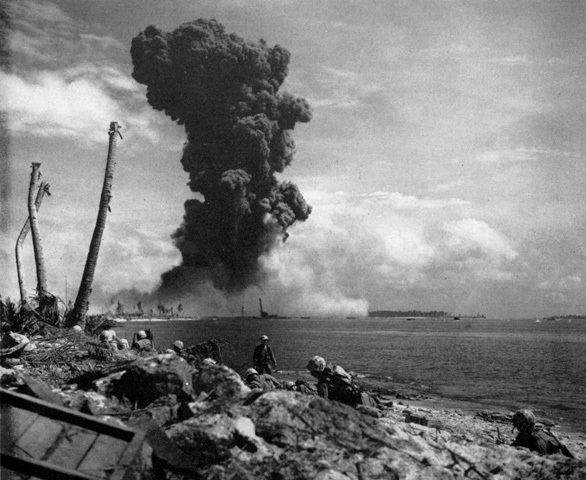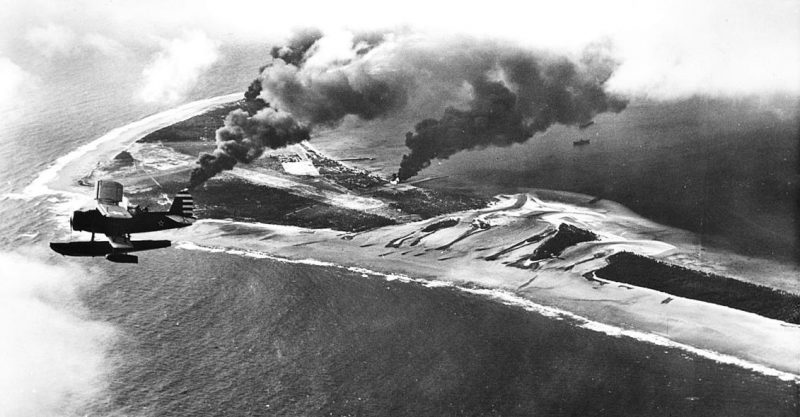Some of the best scuba diving in the Pacific Ocean is reputed to be the deep lagoon of Kwajalein Atoll, because of the American and Japanese ships and planes that sank there during the Second World War.
For a select group of divers who live on the isolated Army missile test base, locating wrecks holding the remains of Americans who died in action is now an all-consuming desire.
It is an indescribable thrill, said Dan Farnham, leader of the Kwajalein MIA Project, when the project squad finds a downed airplane.
The 29-member team, which includes researchers who live on the U.S. mainland, has found 50 percent of the eight U.S. aircraft that went down in the lagoon during WWII. Remaining unaccounted for are the remains of 11 MIAs associated with those eight planes.
The project is collaborating with the Defence POW/MIA Accounting Agency located in Hawaii, which dispatched a team in August to have a closer look.
Kwajalein Atoll was the site of a brief but strong battle by U.S. Marines, soldiers and sailors in 1944 to recapture from the Japanese a strategically vital chain of about 100 tiny islands. Japanese forces had constructed airstrips on Roi-Namur and Kwajalein Islands.
To conjure up an image of the atoll, visualize a volcano sticking up thousands of feet above the ocean floor, with coral islands around the perimeter. The water within that hollow, an 840-square mile lagoon, is rarely deeper than 200 feet.
Within their search area, depths are anywhere from 80 to 150 feet, said Farnham.
They do not dive below 130 feet for safety reasons, but that is sufficient. If they locate a plane below 150 feet, they linger at 20 feet above it, which is sufficient to determine if that is the vessel they are looking for, he explained.
Farnham, who works with the Ronald Reagan Ballistic Missile Defense Test Site in mission control, arrived at Kwajalein on a two-year contract but is now in his 11th year at the site. Diving became his major activity.
All the people he dives with are history aficionados, he said.
Divers decided to locate a Kingfisher float plane that had been a spotter aircraft off the battleship USS New Mexico after Farnham came across a reference to a plane that had crashed in the lagoon on Jan. 31, 1944, after being hit by Japanese anti-aircraft fire from Ebeye Island only a few miles distant.

The search became more than that. One of Farnham’s friends on the U.S. mainland started investigating the crash, discovering that the radioman in the rear seat, Harrison Miller, had been saved from the crash by a minesweeper. He was still alive and residing in Florida.
They had a living veteran who was in the aircraft when it went down and had attempted to get the pilot out when the plane crashed in the lagoon. He could not do it, and the plane went to the bottom with the pilot still in it, he recalled.
That took on an entirely new meaning because as Farnham was talking to the veteran on the phone, he is telling him about the story from 70 years in the past. It obviously still concerned him. So now the team was on a mission.
Miller passed away in 2014, but one of the rescuers aboard the minesweeper recalls the incident.
He had been sitting there on the plane’s pontoon about six hours or so, said Burl Sousa, 94, who lives in Oregon. He was drenched with fuel.
After getting Miller aboard, they fastened a steel cable to the plane, floating upside down in the water. But the minesweeper soon began to take considerable fire from a nearby island, and the cable broke when the ship sprinted forward.
Divers are still trying to find the Kingfisher that prompted their pursuit initially. But their efforts led the team to enlarge their search for all other planes that crashed in the lagoon with accompanying MIAs.
The diving team eight years ago found the wreckage associated with one MIA, a PBM-3D Mariner, a bomber patrol plane, off the north terminus of Ebeye Island.
They found an F6F-3 Hellcat in 2011 with an associated MIA pilot off Bigej Island in the main part of the atoll. That same year, they located the nose section of a Coronado patrol bomber. But it was not until last year were they able to confirm it belonged to an airplane that listed one passenger and one crew member as MIA.
In 2015, they found the rear half of another Coronado, which had separated during a rough landing in August 1944 in the lagoon. Project divers are still searching for the other half.
The divers have gotten blueprint manuals for each of the crashed aircraft to identify fragments.
So even if the plane is in pieces, it might take some time to identify it, but as a rule within a day or so at most they are going to know precisely what they have, Farnham said.
He is confident that human remains could still be within the planes, even after over seven decades in warm Pacific salt water, Stars and Stripes reported.
The project is in touch with the next of kin for all except for a couple of the nearly 12 MIA servicemen in the lagoon. Two of them are sons of the MIAs who have recollections of sitting on their father’s knees, Farnham said.
The team collects all the information it has gathered on a missing family member and the circumstances surrounding the death, then delivers it to the surviving relatives they find.
They witness the effect has on the families when the information is passed on to them, he said, and that motivates them to find the remainder of those airplanes.
